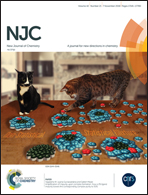Design and synthesis of polymeric carbon nitride@zeolitic imidazolate frameworks (CoWS) semiconductor junction nanowires for efficient photocatalytic hydrogen evolution
Abstract
A stable and efficient photocatalyst has been a key important research goal up to now. In this study, novel PCN@ZIF-9(CoWS) semiconductor junction nanowires were synthesized via a facile in situ growth strategy for the first time. This semiconductor junction photocatalyst exhibits excellent photocatalytic hydrogen evolution: namely, the hydrogen production reached 160 μmol in a 15% (v/v) triethanolamine (TEOA) aqueous solution at pH = 9 in five-hours of continuous light, which was about 53 times and 14 times more than that over ZIF-9 (Co) and PCN (polymeric carbon nitride) respectively under the same conditions. Moreover, the semiconductor junction nanowires could remarkably facilitate the separation and migration of photoinduced charge carriers and offer rich active sites for surface redox reactions. This correlation between electron transfer and photocatalytic activity provides new insight into structural modifications for controlling the charge separation dynamics and activity of carbon-based photocatalysts. In addition, a possible reaction mechanism was proposed.



 Please wait while we load your content...
Please wait while we load your content...